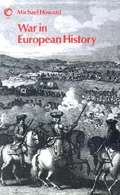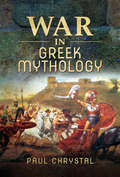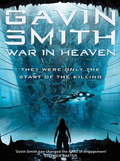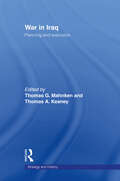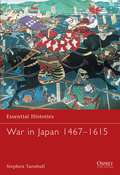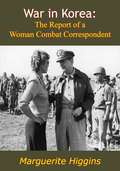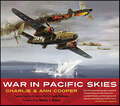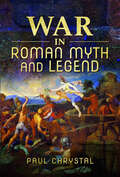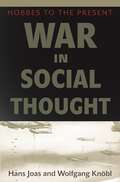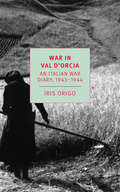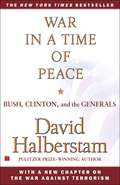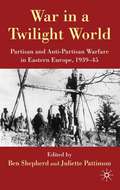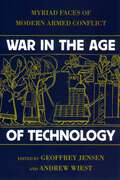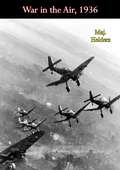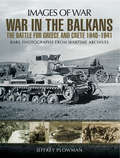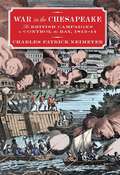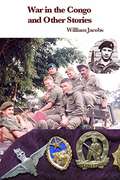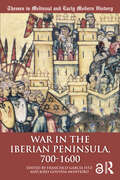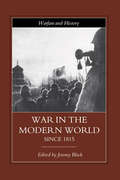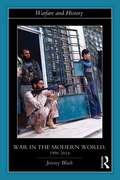- Table View
- List View
War in European History
by Michael HowardThrough gripping stories, research and narrative, DeFoore explores the many faces of anger, including passive anger, anger during the grief process, anger among males, and anger that can actually help us connect with our spirituality and life purpose.
War in Greek Mythology
by Paul ChrystalA study of the Greek mythological wars between Olympians, Titans, giants, centaurs, lapiths and humans, and their significant influence on later cultures.Even though war and conflict generally feature prominently in Greek mythology, comparatively little has been written on the subject. This is surprising because wars and battles in Greek mythology are freighted with symbolism and laden with meaning and significance—historical, political, social and cultural. The gods and goddesses of war are prominent members of the Greek pantheon: the battles fought by and between Olympians, Titans, giants and Amazons, between centaurs and lapiths, were pivotal in Greek civilization. The Trojan War itself had huge and far-reaching consequences for subsequent Greek culture.The ubiquity of war themes in the Greek myths reflects the prominence of war in everyday Greek life and society, which makes the relative obscurity of published literature all the more puzzling.This book redresses this by showing how conflict in mythology and legend resonated loudly as essential, existentialist even, symbols in Greek culture and how they are represented in classical literature, philosophy, religion, feminism, art, statuary, ceramics, architecture, numismatics, etymology, astronomy, even vulcanology.Praise for War in Greek Mythology“An excellent study of the more military of the Greek myths, telling the stories while also acknowledging the many different versions of so many of them, and also the varying attitudes of the ancient Greeks to these stories.” —History of War
War in Heaven
by Gavin G. SmithThe high-powered sequel to VETERAN sees an unlikely hero make an even more unlikely return to take the reader back into a vividly rendered bleak future. But a bleak future where there are still wonders: man travelling out into the universe, Bladerunneresque cities hanging from the ceilings of vast caverns, aliens that we can barely comprehend.Gavin Smith writes fast-moving, incredibly violent SF thrillers but behind the violence and the thrills lies a carefully thought out story and characters who have far more to them than first meets the eye.Never one to avoid controversy Gavin Smith nevertheless invites you to think beyond the initial shock of what you have just read. But in the meantime? Another fire-fight, another chase another flight of imagination.
War in Iraq: Planning and Execution (Strategy and History)
by Thomas G. Mahnken Thomas A. KeaneyThis volume provides a collection of insightful essays on all phases of the Iraq War: both US-led major combat operations to defeat the Ba’athist regime as well as efforts to reconstruct the country and defeat the insurgency. Written by leading scholars on the Iraq War, many of whom have practical first-hand experience of the war, the book includes a Conclusion by leading US strategic thinker Eliot Cohen. This is the first work on the Iraq War to incorporate an understanding of the Iraqi side of the war, based on a systematic analysis of captured Iraqi archives. War in Iraq will be of great interest to students of the Iraq War, small wars and insurgencies, international security and strategic studies in general.
War in Japan 1467-1615
by Stephen TurnbullIn 1467 the Onin War ushered in a period of unrivalled conflict and rivalry in Japan that came to be called the Age of Warring States or Sengoku Jidai. In this book Stephen Turnbull offers a masterly exposition of the Sengoku Jidai, detailing the factors that led to Japan's disintegration into warring states after more than a century of peace; the years of fighting that followed; and the period of gradual fusion when the daimyo (great names) strove to reunite Japan under a new Shogun. Peace returned to Japan with the end of the Osaka War in 1615, but only at the end of the most violent, turbulent and cruel period in Japanese history.
War in Korea: The Report of a Woman Combat Correspondent
by Marguerite HigginsNot since Ernie Pyle have the American people taken any reporter to their hearts as they have Marguerite Higgins—the photogenic young war correspondent for the New York Herald Tribune. This brilliant woman reporter, greatly admired by the fighting men, has dodged bullets with troops on the line, has asked neither favor nor privilege for herself, and has been commended publicly for bravery in helping grievously wounded men under fire. This is her up-front, personal report of the human side of the war.With the discerning eye of the expert reporter and the sympathy of a woman living through the agony of her countrymen, Miss Higgins tells the whole story of the bitter Korean campaign: young, green troops maturing in battle, Communist bullets kicking over the coffeepot at breakfast, the initial inadequacy of American arms, and the terrible price in men we are paying for unpreparedness.Miss Higgins also sketches brilliant thumbnail portraits of Generals MacArthur Walker, and Dean, and of many line and staff officers as well as GIs. In WAR IN KOREA she has written a tremendously compelling book that calls a spade a spade as it reveals the hell and heroism of an ordeal which compares to Valley Forge in the annals of American fighting men.Richly illustrated throughout with photographs by Carl Mydans of Life magazine and others.
War in Pacific Skies
by Ann Cooper Charlie CooperPaintings by the renowned aviation artist plus “lots of wartime photographs and plenty of entertaining and informative text. . . . absorbing reading” (Aviation History).Climb in to the cockpit of some of America’s most heralded warbirds, like the P-38 that carried Richard Bong to his forty kills, and fly along with Paul Tibitts in the Enola Gay as it makes its final approach on Hiroshima. This lavishly illustrated book covers the most famous air engagements in World War II’s Pacific Theater of Operation in an exquisite and beautiful fusion of art and history. Paintings by acclaimed aviation artist Jack Fellows are supplemented by color maps, previously unpublished photographs, original artwork, and personal accounts.
War in Palestine, 1948: Israeli and Arab Strategy and Diplomacy (Israeli History, Politics and Society)
by David TalArab involvement in the Jewish-Palestine conflict had started during the late 1930s, but it was only in the wake of the UN Partition Resolution of 29 November 1947 that active military intervention was considered. The Arab League tried to form a unified army that would prevent the implementation of the Partition Resolution, but failed. In Egypt, the government and the army opposed the idea of dispatching an expeditionary force to Palestine, but the pressure of public opinion and King Farouq's insistence carried the day. The order was given and in May 1948, Egyptian forces crossed the international border with Palestine. The author analyses the reasons for the decisive victory enjoyed by Israel over a larger opponent; and the successes and failures that were sealed in the Egyptian-Israeli General Armistice Agreement signed in Rhodes in March 1948.
War in Roman Myth and Legend
by Paul ChrystalAn enlightening look at the importance of war gods and their myths to the ancient Romans.This book redresses the relative lack of work published on the role of war in classical myth and legend. At the same time it debunks the popular view that the Romans had little mythology of their own and idly borrowed and adapted Greek myth to suit their own ends. While this is true to some extent, War in Roman Myth and Legend clearly demonstrates a rich and meaningful independent mythology at work in Roman culture.The book opens by addressing how the Romans did adopt and adapt Greek myths to fashion the beginnings of Roman history; it goes on to discuss the Roman gods of war and the ubiquity of war in Roman society and politics and how this was reflected in the Aeneas Foundation Myth, the Romulus and Remus Foundation Myth, and the legends associated with the founding of Rome. Also discussed are warlike women in Roman epic; Trojan heroes; and the use of mythology by Roman poets other than Virgil. The Theban Legion and the vision of Constantine myths conclude the journey.
War in Social Thought: Hobbes to the Present
by Wolfgang Knöbl Hans JoasA sweeping history of social theories about war and peace, from Hobbes to the twenty-first centuryThis book, the first of its kind, provides a sweeping critical history of social theories about war and peace from Hobbes to the present. Distinguished social theorists Hans Joas and Wolfgang Knöbl present both a broad intellectual history and an original argument as they trace the development of thinking about war over more than 350 years—from the premodern era to the period of German idealism and the Scottish and French enlightenments, and then from the birth of sociology in the nineteenth century through the twentieth century. While focusing on social thought, the book draws on many disciplines, including philosophy, anthropology, and political science.Joas and Knöbl demonstrate the profound difficulties most social thinkers—including liberals, socialists, and those intellectuals who could be regarded as the first sociologists—had in coming to terms with the phenomenon of war, the most obvious form of large-scale social violence. With only a few exceptions, these thinkers, who believed deeply in social progress, were unable to account for war because they regarded it as marginal or archaic, and on the verge of disappearing. This overly optimistic picture of the modern world persisted in social theory even in the twentieth century, as most sociologists and social theorists either ignored war and violence in their theoretical work or tried to explain it away. The failure of the social sciences and especially sociology to understand war, Joas and Knöbl argue, must be seen as one of the greatest weaknesses of disciplines that claim to give a convincing diagnosis of our times.
War in Val D'Orcia: An Italian War Diary, 1943-1944
by Iris Origo<p>A classic of World War II, here in its first American edition. War in Val d'Orcia is Iris Origo's elegantly simple chronicle of daily life at La Foce, a manor in a Tuscan no-man's land bracketed by foreign invasion and civil war. <p>With the immediacy only a diary can have, the book tells how the Marchesa Origo, an Anglo-American married to an Italian landowner, kept La Foce and its farms functioning while war threatened to overrun it and its people. She and her husband managed to protect their peasants, succor refugee children from Genoa and Turrin, hide escaped Allied prisoners of war-and somehow stand up to the Germans, who in dread due course occupied La Foce in 1944 and forced the Marchesa to retreat under a hot June sun. <p>Fleeing eight impossible miles on foot, along a mined road under shell fire, with sixty children in tow, she sheltered her flock in the dubious safety of a nearby village. A few days later, official Fascism disappeared, and La Foce was ransacked by the retreating Wehrmacht. Here, as the restoration of La Foce begins, her book ends. <p>Beyond praise and above mere documentary value, War in Val d'Orcia belongs to the literature of humanity.</p>
War in Val d'Orcia: An Italian War Diary, 1943-1944
by Virginia Nicholson Iris OrigoIn the Second World War, Italy was torn apart by German armies, civil war, and the Allied invasion. In a corner of Tuscany, one woman—born in England, married to an Italian—kept a record of daily life in a country at war. Iris Origo’s powerful diary, War in Val d’Orcia, is the spare and vivid account of what happened when a peaceful farming valley became a battleground.At great personal risk, the Origos gave food and shelter to partisans, deserters, and refugees. They took in evacuees, and as the front drew closer they faced the knowledge that the lives of thirty-two small children depended on them. Origo writes with sensitivity and generosity, and a story emerges of human acts of heroism and compassion, and the devastation that war can bring.
War in a Time of Peace: Bush, Clinton, and the Generals
by David HalberstamPulitzer Prize-winning journalist David Halberstam chronicles Washington politics and foreign policy in post Cold War America.Evoking the internal conflicts, unchecked egos, and power struggles within the White House, the State Department, and the military, Halberstam shows how the decisions of men who served in the Vietnam War, and those who did not, have shaped America's role in global events. He provides fascinating portraits of those in power—Clinton, Bush, Reagan, Kissinger, James Baker, Dick Cheney, Madeleine Albright, and others—to reveal a stunning view of modern political America.
War in a Twilight World
by Ben Shepherd Juliette PattinsonCutting-edge case studies examine the partisan and anti-partisan warfare which broke out across German-occupied eastern Europe during World War Two, showing how it was shaped in varied ways by factors including fighting power, political and economic structures, ideological and psychological influences, and the attitude of the wider population.
War in the Age of Technology: Myriad Faces of Modern Armed Conflict
by Myriad Faces of Modern Armed ConflictTechnology of one kind or another has always been a central ingredient in war. The Spartan king Archidamus, for instance, reacted with alarm when first witnessing a weapon that could shoot darts through the air. And yet during the past two centuries technology has played an unprecedented role in military affairs and thinking, and in the overall conduct of war. In addition, the impact of new technology on warfare has brought major social and cultural changes. This volume explores the relationship between war, technology, and modern society over the course of the last several centuries. The two world wars, total conflicts in which industrial technology took a terrible human toll, brought great changes to the practice of organized violence among nations; even so many aspect of military life and values remained largely unaffected. In the latter half of the twentieth century, technology in the form of nuclear deterrence appears to have prevented the global conflagration of world war while complicating and fueling ferocious regional contests. A stimulating fusion of military and social history, extending back to the eighteenth century, and with contributions from such leading historians as Brian Bond, Paddy Griffith, and Neil McMillen, War in the Age of Technology will interest lay readers and specialists alike.
War in the Air, 1936
by Claud W. Sykes Major HeldersIn War in the Air, 1936, which was first published in English in 1932, author Robert Knauss fantasizes about a confrontation between England and France. Writing under the pseudonym “Major Helders,” and using detailed descriptions of battles, strategies, and weaponry, Knauss’ aim is for the reader to realize that air power (in general) and ‘flying fortress’ bombers (in particular) would decide the outcome of the next war.In this novel, the hero is the English air force commander Brackley, a carbon copy of the imaginary German leaders in other right-wing prophecies: firm, mysterious, infallible. In times of crisis, he surveys the situation “with lightning speed.” His war is one of movement, of risk-taking, of annihilation. Modern airplane technology allows him to carry out a style of warfare that fits his chivalric, warrior spirit. Only for an instant does he pity the population of Paris as his planes pour bombs over the city in a surprise attack. Pity, though, is not a virtue in the nationalist mind, though Vernichtungswille [the will to annihilate] is…
War in the Balkans: The Battle for Greece and Crete, 1940–1941 (Images of War)
by Jeffrey PlowmanThis WWII pictorial history presents a vivid look at the Balkan campaign from Italy&’s invasion of Greece to the Nazi airborne assault on Crete. Through rare wartime photographs, War in the Balkans traces the course of the entire Balkan campaign. Beginning with Mussolini&’s first act of aggression, the narrative continues through Albania, the invasions of Yugoslavia and Bulgaria by German forces, and on to the battle for Greece and the final airborne assault on Crete. Historian Jeffrey Plowman gives equal weight to every stage of the campaign and covers all the forces involved: the Italians, Germans, Greeks, and British Commonwealth troops. By shifting the focus to the mainland—rather than the culminating Battle of Crete—Plowman views the campaign as a whole, offering a balanced portrayal of a conflict that is often overlooked in histories of the Second World War. Most of the photographs included here have never been published before, and many come from private sources. They are a unique visual record of the military vehicles, tanks, aircraft, artillery and other equipment used by the opposing armies. They also show the conditions the soldiers faced, and the landscape of the Balkans over which they fought.
War in the Chesapeake
by Charles Patrick NeimeyerIn the early nineteenth century, the United States of America was far from united. The United States faced internal strife over the extent of governance and the rights of individual states. The United States’ relationship with their former colonial power was also uncertain. Britain impressed American sailors and supported Native Americans’ actions in the northwest and on the Canadian border. In the summer of 1812, President James Madison chose to go to war against Britain. War in the Chesapeake illustrates the causes for the War of 1812, the political impacts of the war on America, and the war effort in the Chesapeake Bay. The book examines the early war efforts, when both countries focused efforts on Canada and the Northwest front. Some historians claim Madison chose to go to war in an attempt to annex the neighboring British territories. The book goes on to discuss the war in the Chesapeake Bay. The British began their Chesapeake campaign in an effort to relieve pressure on their defenses in Canada. Rear Admiral George Cockburn led the resulting efforts, and began to terrorize the towns of the Chesapeake. From Norfolk to Annapolis, the British forces raided coastal towns, plundering villages for supplies and encouraging slaves to join the British forces. The British also actively campaigned against the large American frigates- seeing them as the only threat to their own naval superiority. War in the Chesapeake traces these British efforts on land and sea. It also traces the Americans’ attempts to arm and protect the region while the majority of the American regular forces fought on the Northwest front. In the summer campaign of 1814, the British trounced the Americans at Bladensburg, and burned Washington, D. C. Afterwards, the Baltimoreans shocked the British with a stalwart defense at Fort McHenry. The British leaders, Vice Admiral Sir Alexander Cochrane and Major General Robert Ross, did not expect strong resistance after their quick victories at Bladensburg. War in the Chesapeake tells the story of some of the earliest national heroes, including the defenders of Baltimore and naval leaders like John Rodgers and Stephen Decatur. The following December 1814, the United States and Britain signed the Treaty of Ghent, ending hostilities and returning North America to a peaceful status quo. The United States and neighboring Canada would not go to war on opposing sides again. The United States left the war slightly more unified and independent of the British.
War in the Congo and Other Stories
by William Jacobs<p>William "Bill" Jacobs never backed down from adventure anywhere he found it. This book contains his personal record of some of the highlights of his life. It starts with his time in the British Parachute Regiment, then the bulk of the story tells of his two contracts, in 1966 and 1967, as a "mercenary" in the Congo where he was commissioned as a Lieutenant on his second contract. The book also includes a few anecdotes of such as his short-lived career as a crocodile hunter and some other vignettes. <p>No sensibilities are spared in his telling of the story. The style is clearly one of recollection as he consulted his diary lf the events, so much of the content has a sense of rawness and immediacy with reinforces the reality of this being a real story and not a made-for-Hollywood story.</p>
War in the Deep: Pacific Submarine Action in World War II
by Edwin P. HoytNo one ever lived more dangerously than those who took to the depths of the Pacific Ocean in submarines during World War II. In this book the well-known author Edwin P. Hoyt tells the exciting story of those perilous days when submariners of the U. S. navy, at first outnumbered by their Japanese enemies, put to sea in outmoded boats armed with faulty torpedoes. War in the Deep recounts hazardous adventure after adventure experienced by both Americans and Japanese. It follows the comeback of American submarines and their daring forays that led to their vital role in the economic strangulation of Japan.
War in the Iberian Peninsula, 700–1600 (Themes in Medieval and Early Modern History)
by Francisco García Fitz João Gouveia MonteiroWar in the Iberian Peninsula, 700–1600 is a panoramic synthesis of the Iberian Peninsula including the kingdoms of Leon and Castile, Aragon, Portugal, Navarra, al-Andalus and Granada. It offers an extensive chronology, covering the entire medieval period and extending through to the sixteenth century, allowing for a very broad perspective of Iberian history which displays the fixed and variable aspects of war over time. The book is divided kingdom by kingdom to provide students and academics with a better understanding of the military interconnections across medieval and early modern Iberia. The continuities and transformations within Iberian military history are showcased in the majority of chapters through markers to different periods and phases, particularly between the Early and High Middle Ages, and the Late Middle Ages. With a global outlook, coverage of all the most representative military campaigns, sieges and battles between 700 and 1600, and a wide selection of maps and images, War in the Iberian Peninsula is ideal for students and academics of military and Iberian history.
War in the Iberian Peninsula, 700–1600 (Themes in Medieval and Early Modern History)
by Francisco García Fitz and João Gouveia MonteiroWar in the Iberian Peninsula, 700–1600 is a panoramic synthesis of the Iberian Peninsula including the kingdoms of Leon and Castile, Aragon, Portugal, Navarra, al-Andalus and Granada. It offers an extensive chronology, covering the entire medieval period and extending through to the sixteenth century, allowing for a very broad perspective of Iberian history which displays the fixed and variable aspects of war over time.The book is divided kingdom by kingdom to provide students and academics with a better understanding of the military interconnections across medieval and early modern Iberia.The continuities and transformations within Iberian military history are showcased in the majority of chapters through markers to different periods and phases, particularly between the Early and High Middle Ages, and the Late Middle Ages.With a global outlook, coverage of all the most representative military campaigns, sieges and battles between 700 and 1600, and a wide selection of maps and images, War in the Iberian Peninsula is ideal for students and academics of military and Iberian history.Chapter 6 of this book is freely available as a downloadable Open Access PDF at http://www.taylorfrancis.com under a Creative Commons [Attribution-Non Commercial-No Derivatives (CC BY-NC-ND)] 4.0 license.
War in the Modern World since 1815 (Warfare and History)
by Jeremy BlackConflict is central to human history. It is often the cause, course and consequence of social, cultural and political change. Military history therefore has to be more than a technical analysis of armed conflict. War in the Modern World since 1815 addresses war as a cultural phenomenon, discusses its meaning in different socities and explores the various contexts of military action.
War in the Modern World, 1990-2014 (Warfare and History)
by Jeremy BlackIn War in the Modern World, 1990-2014, Jeremy Black looks at the most modern of conflicts from the perspective that war is a central feature of the modern world. Arguing that understanding non-Western developments is crucial if the potential of Western war-making is to be assessed accurately, the book also asserts that knowing the history of conflict can only help future generations. Black argues for the need to emphasise the variety of military circumstances, as well as the extent to which the understanding of force and the definitions of victory and defeat are guided by cultural assumptions. War has a multi-faceted impact in the modern world, and this book shows its significance. As the latest volume in the Warfare and History series, this title takes a global and historical perspective on modern warfare, enabling the reader to approach familiar conflicts through a new analytical framework. This book is an invaluable resource for all students of the history of modern warfare.
War in the Pacific: Formidable Foe – 1942-1943 (War In The Far East Ser. #1)
by Peter HarmsenWar in the Pacific is a trilogy of books comprising a general history of the war against Japan; unlike other histories it expands the narrative beginning long before Pearl Harbor and encompasses a much wider group of actors to produce the most complete narrative yet written and the first truly international treatment of the epic conflict.War in the Pacific: Formidable Foe – 1942-1943 Details the astonishing transformation that took place from 1942 to 1943, setting the Allies on a path to final victory against Japan. The central importance of China is highlighted in a way that no previous general history of the war against Japan has achieved.
